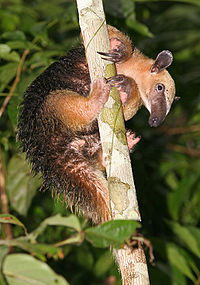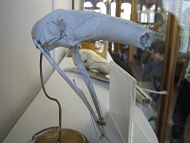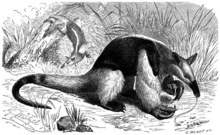- Southern tamandua
-
Southern Tamandua[1] 
Southern Tamandua, Cocoal, Brazil Conservation status Scientific classification Kingdom: Animalia Phylum: Chordata Class: Mammalia Superorder: Xenarthra Order: Pilosa Suborder: Vermilingua Family: Myrmecophagidae Genus: Tamandua Species: T. tetradactyla Binomial name Tamandua tetradactyla
(Linnaeus, 1758)
Southern tamandua range The southern tamandua, also called a collared anteater, or lesser anteater (Tamandua tetradactyla), is a species of anteater from South America. It is a solitary animal, found in many habitats from mature to highly disturbed secondary forests and arid savannas. It feeds on ants, termites and bees. It has very strong foreclaws that can be used to break insect nests or to defend itself.
Contents
Distribution and habitat
The southern tamandua is found in South America from Venezuela and Trinidad to northern Argentina, southern Brazil, and Uruguay at elevations to 1,600 metres (5,200 ft). It inhabits both wet and dry forests, including tropical rainforest, savanna, and thorn scrub.[3] It seems to be most common in habitats near streams and rivers, especially those thick with vines and epiphytes (presumably because its prey is common in these areas).[citation needed]
The oldest fossil tamanduas date from the Pleistocene of South America, although genetic evidence suggests that they may have diverged from their closest relative, the giant anteater, in the late Miocene, 12.9 million years ago.[4]
Subspecies
There are four recognised subspecies:
- Tamandua tetradactyla tetradactyla (Linnaeus, 1758) - southern and eastern Brazil, Uruguay
- Tamandua tetradactyla nigra (Geoffroy, 1803) - northern Brazil, Colombia, Venezuela, Trinidad, the Guianas
- Tamandua tetradactyla quichua (Thomas, 1927) - Peru, Ecuador, extreme western Brazil
- Tamandua tetradactyla straminea (Cope, 1889) - southern Brazil, Paraguay, Bolivia, Argentina
Physical description
The southern tamandua is a medium-sized anteater, with a combined head and body length ranging from 34 to 65 centimetres (13 to 26 in), and a prehensile tail 37 to 67 centimetres (15 to 26 in) long. Adults weigh from 3.4 to 8.4 kilograms (7.5 to 19 lb); there is no significant difference in size between males and females.[3] Like their close relative, the northern tamandua, they have four clawed digits on the forefeet and five on the hindfeet, and walk on the outer surface of their forefeet, to avoid puncturing their palms with their sharp claws. The underside and the tip of the tail are hairless. The snout is long and decurved with an opening only as wide as the diameter of a stick, from which the tongue is protruded. Although there are also some differences in the shape of the skull, they can most easily be distinguished from the northern tamandua by their slightly longer ears, which average around 5 centimetres (2.0 in), instead of 4 centimetres (1.6 in) as in the northern species[3].
The individual and geographic variation observed in the southern tamandua has made the taxonomic description of these animals a difficult task. Animals from the southeastern part of the range are "strongly vested", meaning that they have black markings from shoulder to rump; the black patch widens near the shoulders and encircles the forelimbs . The rest of the body can be blonde, tan, or brown. Animals from northern Brazil and Venezuela to west of the Andes are solid blonde, brown, or black, or are only lightly vested.[citation needed]
Reproduction
Females are polyestrous; mating generally takes place in the fall. Gestation ranges from 130 to 190 days[3] and one young is born in the spring. At birth the young anteater does not resemble its parents; its coat varies from white to black. It rides on the mother's back for a period of time and is sometimes deposited on a safe branch while the mother forages.
Behavior
The tamandua is mainly nocturnal but is occasionally active during the day. They nest in hollow tree trunks or in the burrows of other animals, such as armadillos. They are solitary, occupying home ranges that average from 100 to 375 hectares (250 to 930 acres), depending on the local environment.[3]
They may communicate when aggravated by hissing and releasing an unpleasant scent from the anal gland. It spends much of its time foraging arboreally; a study in various habitats in Venezuela[citation needed] showed that this anteater spends 13 to 64 percent of its time in trees. In fact, the southern tamandua is quite clumsy on the ground and ambles along, incapable of the gallop that its relative, the giant anteater, can achieve.
The southern tamandua uses its powerful forearms in self-defense. If it is threatened in a tree it grasps a branch with its hindfeet and tail, leaving its arms and long, curved claws free for combat. If attacked on the ground, this anteater backs up against a rock or a tree and grabs the opponent with its forearms. In the rainforest, the southern tamandua is surrounded during the day by a cloud of flies and mosquitoes and is often seen wiping these insects from its eyes.[citation needed] This animal has small eyes and poor vision, but its large, upright ears indicate that hearing is an important sense.
Diet
Southern tamanduas eat ants and termites in roughly equal proportions, although they may also eat a small quantity of fruit. They locate their food by scent, and prey on a wide range of species, including army ants, carpenter ants, and Nasutitermes.[3] They avoid eating ants that are armed with strong chemical defenses, such as leaf-eating ants[citation needed]. Tamanduas are also thought[by whom?] to eat honey and bees and, in captivity, have been known to eat fruit and meat as well. Anteaters extract their prey by using their extremely strong forelimbs to rip open nests and their elongated snouts and rounded tongues (up to 40 centimetres (16 in) in length) to lick up the insects.
Although it has the same diet as the giant anteater, both animals are able to live alongside one another, perhaps because the southern tamandua is able to reach nests in trees, while its larger cousin cannot.[3]
Conservation
The southern anteater is listed as CITES Appendix II in southeastern Brazil. Although widespread, they are uncommon. They are killed by hunters, who claim that tamanduas kill dogs. They are also killed for the thick tendons in their tails, from which rope is made. Tamanduas are sometimes used by Amazonian Indians to rid their homes of ants and termites.[citation needed]
References
- ^ Gardner, Alfred L. (16 November 2005). "Order Pilosa (pp. 100-103)". In Wilson, Don E., and Reeder, DeeAnn M., eds. Mammal Species of the World: A Taxonomic and Geographic Reference (3rd ed.). Baltimore: Johns Hopkins University Press, 2 vols. (2142 pp.). p. 103. ISBN 978-0-8018-8221-0. OCLC 62265494. http://www.bucknell.edu/msw3/browse.asp?id=11800048.
- ^ Abba, A., Lara-Ruiz, P. & Members of the IUCN SSC Edentate Specialist Group (2008). Tamandua tetradactyla. In: IUCN 2008. IUCN Red List of Threatened Species. Downloaded on 28 November 2008.
- ^ a b c d e f g Hayssen, V. (2011). "Tamandua tetradactyla (Pilosa: Myrmecophagidae)". Mammalian Species 43 (1): 64–74. doi:10.1644/875.1.
- ^ Barros, M.C., et al. (2003). "Phylogenetic analysis of 16S mitochondrial DNA data in sloths and anteaters". Genetics and Molecular Biology 26 (1): 5–11. doi:10.1590/S1415-47572003000100002.
- Louise H. Emmons and Francois Feer, 1997 - Neotropical Rainforest Mammals, A Field Guide.
- Gorog, A. 1999. "Tamandua tetradactyla" from Animal Diversity Web.
Extant Pilosa species by suborder Bradypodidae Megalonychidae Cyclopedidae Myrmecophagidae CategoryCategories:- IUCN Red List least concern species
- Anteaters
- Myrmecophagous mammals
- Mammals of South America
- Mammals of Guyana
- Mammals of Colombia
- Animals described in 1758
Wikimedia Foundation. 2010.



